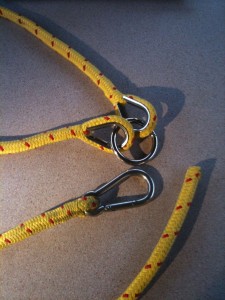Maybe it’s just February talking here, but I can’t think of a better way to spend a rainy Saturday morning on the boat than to make a pot of coffee and teach myself how to splice double-braid rope.

Splicing is the method by which a rope is woven back into itself in a permanent way. Splices are most often used to create a loop (or ‘eye’) at the end of a rope, but you can also splice two pieces of rope together or splice a rope to a chain, and a ‘back splice’ is a great way to make the end of a rope tidy and fray-proof. There are probably some excellent reasons why splicing is superior to just using knots, but to be honest I think for me it just comes down to a combination of two things; a masochistic fascination for learning the arcane technical details and trappings of a hobby, and a somewhat puzzling affection towards ropes and wires.
The first bit, the drive to learn, isn’t even remotely surprising given my age and gender; all men need some sort of intellectually stimulating hobby. I guess in another dimension I could be putting that portion of my brain to work studying the minutiae of some athlete’s SuperBowl records, but frankly I just can’t seem to understand the drive to watch other people play sports. Back when I was trying to be a techno rockstar, I justified my obsessive gear hoarding, building and modification by saying “every man needs a model train set, in one form or another…“, and I think it holds true.
The second part is a little baffling though – as a techno guy, I noticed that studio audio cables came in all different grades, from $10 cheap-o patch cords to $150 ultra-high-end ones. I also noticed that the ultra-high-end cables could be built at home using the exact same components for about $30. I proceeded to buy connectors and cable in bulk lots from eBay, and build custom replacements for almost every last cable in my studio. I got a surprising amount of enjoyment out of this – something about sitting down with a fresh spool of cable and a baggie of specialized hardware… the smell of the solder and the feel of the connectors, combined with the sense of accomplishment from having built something excellent and useful. I’ve begun to notice that I get exactly the same feeling from making ‘cables’ for use on the boat; see my previous entry on making new steering cables for another example.
When I purchased TIE Fighter, one of the many, many extras she came with was a sailcloth “ditty bag” with sail-repair tools and a Samson splicing kit. I set it aside with interest, knowing that at some point I’d want to learn the art. In the past year, I’ve come to regard all of the halyards – with their snap-shackles attached with bowline knots – with disdain. They stand out like white socks against a dark business suit; once you’ve seen them, you can’t un-see them. A vessel as fine as TIE Fighter should be rigged appropriately!

Earlier this month I picked up a fifty-foot length of nice yellow floating double-braid line at half-price – not more of that ugly yellow polypropylene garbage, but really nice braided nylon. I figured it would make a perfect new dinghy painter, given that the last painter barely survived the latest windstorm, and so this morning I set down to learn to splice. My kit came with a handy (if tattered and stained) splicing manual, and just by following the directions I was fairly successful. I mean, I do have a bit of a technical history, and I am pretty handy with rope, but I was still able to complete a half-decent eye splice my very first try. That’s a pretty far cry from the $35 – per splice! – I was quoted at the marine store.
I can’t, however, say I had perfect success. The yellow rope in the first photo was supposed to be a pair of three-foot ropes, joined in the middle by a pair of eye splices and a steel O-ring and with a steel carabiner at either end. Oh, it came together just fine – but the ropes, meant to be identical in length so that they could be used as a fancy towing bridle for the zodiac, were not identical in length. Despite my careful measurements, the two ropes are significantly disparate, with one rope about eight inches longer than the other, and this means the bridle is completely useless as it will cause the zodiac to veer strongly to the side with the shorter bridle arm. I’m not sure why exactly this happened, but I’ll mention it tonight when I go to drink scotch with my rigger friend Mike Flynn, in hopes that he nods knowingly and explains where I went wrong in his usual succinct way.
Anyhow. Things progress, and things are slowly calming down. I will hopefully have more time to write.
